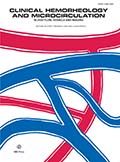Authors: Zhang, Qiubing | Gou, Fang | Shi, Ping | Xu, Zhe | Yan, Zhitao | He, Mingfang | Yin, Xiaohong | He, Yuanjun | Zhang, Jun
Article Type:
Research Article
Abstract:
BACKGROUND: Angiotensin-converting enzyme inhibitors (ACEIs) were reported to protect from hypoxia-induced oxidative stress in coronary endothelial cells (CECs) after acute myocardial infarction (AMI). Nrf2 shows a protective effect in hypoxia-induced CECs after AMI. Plasmalemma vesicle-associated protein (PLVAP) plays a pivotal role in angiogenesis after AMI. AIM: To explore the protective effect of ACEIs and the involved mechanisms under hypoxia challenge. METHODS: Human coronary endothelial cells (HCAECs) were used to establish hypoxia-induced oxidative stress injury in vitro . Flow cytometry was used to evaluate the protective effect of ACEI on hypoxia conditions.ET-1, NO, ROS, and VEGF were
…detected by ELISA. HO-1, Nrf2, and Keap-1, the pivotal member in the Nrf2 signaling pathway, eNOS and PLVAP were detected in HEAECs treated with ACEI by immunofluorescence, qPCR, and western blotting. RESULTS: The hypoxia ACEI or Nrf2 agonist groups showed higher cell viability compared with the hypoxia control group at 24 (61.75±1.16 or 61.23±0.59 vs. 44.24±0.58, both P < 0.05) and 48 h (41.85±1.19 or 59.64±1.13 vs. 22.98±0.25, both P < 0.05). ACEI decreased the levels of ET-1 and ROS under hypoxia challenge at 24 and 48 h (all P < 0.05); ACEI increased the VEGF and NO levels (all P < 0.05). ACEI promoted the expression level of eNOS, HO-1, Nrf2 and PLVAP but inhibited Keap-1 expression at the mRNA and protein levels (all P < 0.05). Blockade of the Nrf2 signaling pathway significantly decreased the expression level of PLVAP. CONCLUSION: ACEI protects hypoxia-treated HEAECs by activating the Nrf2 signaling pathway and upregulating the expression of PLVAP.
Show more
Keywords: Acute myocardial infarction, angiotensin-converting enzyme inhibitor, nuclear factor erythroid 2 signaling pathway, human coronary endothelial cells, plasmalemma vesicle-associated protein
DOI: 10.3233/CH-232007
Citation: Clinical Hemorheology and Microcirculation,
vol. Pre-press, no. Pre-press, pp. 1-30, 2024
Price: EUR 27.50




